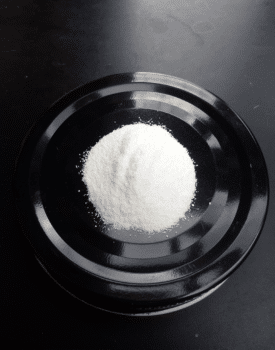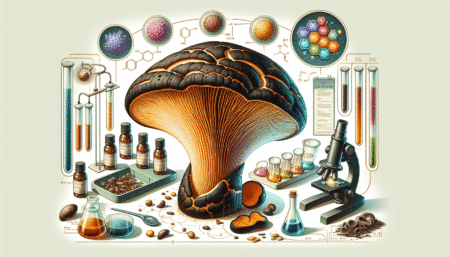- What is gibberillic acid and why is it important?
- The function of gibberillic acid in plant growth
- The effect of gibberillic acid on cell division and elongation
- The influence of gibberillic acid on germination and seed dormancy
- The role of gibberillic acid in flower formation and fruit development
- Possible applications of gibberillic acid in agriculture
- How can you increase the gibberillic acid content in plants?
- Successful examples of the use of gibberillic acid to increase yield or improve quality
- Outlook: Potential for further research into the effects of giberrelin acids
- Conclusion: The growth hormone gibberillic acid - a key to successful plant growth!
Here you can find our gibberillic acid / GA3 products!
Have you always wondered how plants can grow and develop so quickly? The answer lies, among other things, in a fascinating growth hormone called gibberillic acid. In this blog article, you will find out why gibberillic acid is so important for plant growth, how it affects cell division and elongation and what influence it has on germination, flower formation and fruit development. You will also find out how farmers use gibberillic acid in agriculture and how the gibberillic acid content in plants can be increased. Exciting examples of the successful use of this growth hormone will convince you that gibberillic acid is a real key to successful plant growth.
1. what is gibberillic acid and why is it important?
Gibberillic acid is an important growth hormone found in plants. It plays a crucial role in the regulation of various developmental processes and influences the growth and development of plants in a variety of ways. Gibberillic acid not only promotes cell division, but also the elongation of cells, which leads to increased length growth. As a result, it can have a positive influence on plant growth overall. Another important aspect of gibberillic acid is its effect on the germination and seed dormancy of plants. It can stimulate the germination process and thus contribute to the faster development of young plants. At the same time, it can also promote the lifting of seed dormancy, which is of great importance for some species. In addition, gibberillic acid plays an important role in flower formation and fruit development. It can stimulate the formation of flower shoots and thus contribute to the increased production of flowers. This in turn has a positive effect on fruit development by increasing the number and quality of fruits. In agriculture, gibberillic acids are often used to improve the growth of crops or to increase yields.
Through targeted application, certain development processes can be stimulated to create optimal conditions for plant growth. There are various approaches to increasing the gibberillic acid content in plants. One possibility is to select suitable plant varieties that naturally have a higher gibberillic acid content. Another method is to use fertilizers or growth regulators that contain gibberillic acid or promote its production. There are already successful examples of the use of gibberillic acid to increase yield or improve quality in agriculture. For example, it has been found that treatment with gibberellin leads to an increase in the number and size of grains in some cereals. Similar effects have also been observed in fruit and vegetable plants. Overall, the growth hormone gibberellic acid has enormous potential for agricultural production and plant growth as a whole. It offers numerous application possibilities and research approaches to further explore and utilize its effects. With its positive influence on cell division, elongation, germination and fruit development, it is undoubtedly a key to successful plant growth!
2. the function of gibberillic acid in plant growth
The function of gibberillic acid in plant growth Gibberillic acid is an important growth hormone that plays a crucial role in plant growth. It is responsible for regulating various processes in plant cells and thus influencing the growth and development of plants. One of the main functions of gibberillic acid is to promote cell division and elongation. By stimulating the cell cycle, it contributes to the growth of the plant and enables it to adapt its size and shape. It also supports the formation of new tissues and organs. Another important aspect of gibberillic acid's function concerns the germination of seeds and the lifting of seed dormancy. It ensures that seeds can germinate under suitable conditions and thus enables the start of a new plant life cycle. Its stimulating effect on the enzyme alpha-amylase activates the breakdown of starch into sugar in the seeds. In addition, gibberillic acid plays a decisive role in flower formation and fruit development.
It regulates the transition between vegetative growth (leaf and shoot formation) and generative growth (flower and fruit formation). Through its effect on the production of proteins and enzymes, it promotes the formation of flower buds and supports the development of healthy fruit. In agriculture, gibberillic acid is also used specifically to improve plant growth. For example, it can be used to increase yields or improve the quality of crops. Through targeted application, certain development processes can be promoted or inhibited to ensure optimal plant development. There are various approaches to increasing the gibberillic acid content in plants. One possibility is to select plants with a higher genetic content of gibberillic acid or to produce them using breeding methods. Another possibility is the use of gibberellic acid sprays or fertilizers to specifically increase the hormone level in the plants. There are already successful examples of the use of gibberellic acid in agriculture. For example, studies have shown that treating tomato plants with gibberellic acid leads to an earlier and more uniform ripening process, thus improving the quality of the fruit. Similar effects have also been observed in other crops such as wheat, rice and tree fruits. The potential for further research into the effects of gibberellic acid is promising. There are still many unanswered questions and unknown mechanisms that need to be explored in order to understand and maximize the full potential of this growth hormone. In summary, it can be said that gibberillic acid is a key to successful plant growth. Through its diverse functions, it significantly influences the growth and development of plants. Its targeted use in agriculture can help to increase yields and improve the quality of crops. With further research, we can deepen our understanding of this fascinating substance and fully exploit its potential.
3. the effect of gibberillic acid on cell division and elongation
The effect of gibberillic acid on cell division and elongation Gibberillic acid is an important growth hormone in plants that fulfills a variety of functions. One of these functions is to regulate cell division and elongation. By activating certain genes, gibberillic acid controls the process of cell proliferation and at the same time increases the length of the cells. During cell division, gibberillic acid promotes the growth of new cells by stimulating the expression of genes responsible for the division process. This leads to the formation of more cells and faster tissue growth. At the same time, gibberillic acid also stimulates the elongation of existing cells. It does this by increasing the water content in the cells and by changing the structure of the plant cytoskeleton.
However, the exact mode of action of gibberillic acid on cell division and elongation has not yet been fully researched. It is assumed that the hormone interacts with certain receptors in the plant cells and thereby triggers signaling cascades that ultimately lead to the activation or suppression of certain genes. Overall, gibberillic acid plays a crucial role in plant growth by regulating cell division and elongation. By promoting cell proliferation and elongation, it enables rapid and efficient growth of tissues and organs. However, the exact functioning of this hormone remains a subject of intense research to understand the full potential of gibberillic acid in plant growth and possibly discover further applications.
4. the influence of gibberillic acid on germination and seed dormancy
Gibberellic acid plays a decisive role in the germination and seed dormancy of plants. It promotes germination by supporting the process of cell division and elongation in the embryos. During seed dormancy, on the other hand, gibberellic acid inhibits growth and causes the seeds to remain in a dormant state. This mechanism is particularly important for plant species whose seeds have to germinate over a longer period of time under certain conditions, for example if they mature in the fall and are not to germinate until spring. The targeted use of gibberellic acid can increase the germination rate and shorten or eliminate seed dormancy. This enables farmers to achieve earlier harvests, for example, or to control the growth of crops such as cereals or vegetables. Knowledge of the influence of gibberellic acid on germination and seed dormancy therefore enables us to influence plant growth in a targeted manner and thus practice sustainable agriculture. Overall main topic: The growth hormone gibberellic acid Special topic: The influence of gibberellic acid on germination and seed dormancy
5. the role of gibberillic acid in flower formation and fruit development
The role of gibberillic acid in flower formation and fruit development Another important aspect of the growth hormone gibberillic acid is its role in flower formation and fruit development in plants. Gibberillic acid plays a crucial role in regulating these processes by stimulating the production of enzymes that are responsible for the opening of flower buds and fruit development. Gibberillic acid initially promotes the growth of the buds and ensures that they can open. It activates certain genes in the cells of the buds, which leads to the formation of enzymes that enable cell wall degradation. This allows the flower buds to unfold and develop their colorful splendor.
In addition, gibberillic acid also influences the development of the fruit. It promotes cell growth in the tissues around the seed and thus supports the growth and ripening of the fruit. This can lead to increased fruit size and quality. It is important to note that gibberillic acid is not solely responsible for these processes. It interacts with other hormones such as auxins and ethylene to ensure a complex regulation of plant growth. This cooperation creates optimal conditions for plants to flower and bear fruit. Overall, gibberillic acid is an essential growth hormone for flowering and fruit development in plants. It promotes bud growth and allows flowers to unfold, while also stimulating cell growth in the tissues around the seed, leading to successful fruit formation. The exact role of gibberillic acid in these processes continues to be researched in order to realize the full potential of this growth hormone and expand its applications in agriculture.
6. possible applications of gibberillic acid in agriculture
The possible applications of gibberillic acid in agriculture are diverse and offer farmers numerous advantages. Through the targeted addition of gibberillic acid, they can optimize the growth of their plants and thus increase yields. One area of application for gibberillic acid, for example, is in promoting germination and overcoming seed dormancy. By adding the growth hormone, farmers can ensure that their seeds germinate quickly and evenly, resulting in a better yield. In addition, gibberillic acid also has a positive influence on flower formation and fruit development. By using the hormone in a targeted manner, farmers can ensure that their plants produce a high number of flowers and therefore also produce a large amount of fruit. This in turn can lead to an increase in yield. The addition of gibberillic acid can also help to improve the quality of produce. For example, a larger size or a more intense aroma can be achieved in many types of fruit through the use of the growth hormone. Overall, the use of gibberillic acid in agriculture offers many opportunities to optimize plant growth and thus achieve more successful harvests.
7. how can the gibberillic acid content of plants be increased?
Gibberellic acid is an important growth hormone for plants. It plays a crucial role in various developmental processes, such as cell division and elongation, germination and seed dormancy, as well as in flower formation and fruit development. There are various approaches to increasing the gibberillic acid content in plants. One possible way is the targeted selection or breeding of varieties with a higher natural gibberillic acid content. Through crossing and selection, plant species can be developed that naturally produce more of this hormone. Another possibility is to increase the use of external gibberellic acid. This can be done by applying fertilizers containing gibberellic acid or spray treatments to the plant surface. This method enables a direct increase in the hormone content in the plants and can thus have a positive influence on growth. Certain environmental conditions can also increase the gibberellic acid content in plants.
For example, studies have been carried out which show that certain stress factors such as cold or drought can lead to increased production of gibberillic acid. Thus, by creating optimal conditions for growth, higher levels of gibberillic acid can also be achieved indirectly. Overall, increasing the content of gibberillic acid in plants is a promising approach to improving plant growth. The targeted selection of varieties, the use of external gibberellic acid or the creation of optimal environmental conditions can increase the hormone content and thus promote growth. Research in this field still has potential for further investigations and discoveries that can help advance the use of gibberellic acid to increase yield or improve crop quality.
8 Successful examples of the use of gibberillic acid to increase yield or improve quality
An exciting topic surrounding gibberillic acid is its successful use to increase yields or improve the quality of plants. Farmers and gardeners can achieve impressive results through the targeted application of these growth hormones. One example of this is the cultivation of tomatoes, where gibberillic acid is used to increase fruit size. Studies have shown that treatment with gibberellic acid leads to larger and juicier tomatoes. The use of gibberellic acid has also proven to be extremely effective in rice cultivation. It helps the rice plants to grow faster and produce a higher yield. In addition, the addition of gibberillic acid to the soil can also improve the quality of various crops such as wheat, corn and cotton.
The plants show better resistance to diseases and increased drought tolerance. Overall, these examples are convincing proof of the positive influence of gibberillic acid on plant growth and yield in agriculture. It is therefore worth carrying out further research to exploit the full potential of these growth hormones and to understand their effects even better. The growth hormone gibberillic acid thus offers a promising key to successful plant growth.
9 Outlook: Potential for further research on the effects ofiberrelinic acids
Another exciting area of research related to the effects of gibberellic acids is their potential in combating plant diseases. Previous studies have shown that the application of gibberellic acid can strengthen the immune system of plants, leading to improved resistance to pathogenic organisms. This could be of great benefit in agriculture in particular, as reduced susceptibility to diseases can lead to higher yields and better quality of the products grown. However, there are still many unanswered questions regarding the exact mechanisms by which gibberellic acid influences the immune system. Further research could help to better understand these mechanisms and develop innovative approaches to harness the immune-enhancing properties of gibberellic acid.
There is also interest in researching the potential of gibberellic acids as biological pesticides. Targeted manipulation of the gibberellic acid content in plants could make it possible to ward off pests or inhibit their reproduction. Such studies could make an important contribution to the development of more sustainable and environmentally friendly methods of plant protection. Overall, the potential for further research into the effects of giberrelinic acids on plant growth and their possible applications in agriculture offers exciting prospects for the future. It remains to be seen what findings and innovations this research will produce and how it can help to further optimize plant growth.
10 Conclusion: The growth hormone giberrelinic acid - a key to successful plant growth!
Gibberillic acid is an important growth hormone for plants that has a variety of functions in plant growth. It influences both cell division and cell elongation and plays a crucial role in germination and seed dormancy. Gibberillic acid also promotes flower formation and fruit development. In agriculture, it is used to increase yields or improve the quality of plants. Various methods can be used to increase the gibberillic acid content in plants. Successful examples show how the targeted use of gibberillic acid can lead to positive results. However, the potential of gibberillic acid has not yet been fully explored.
Future studies could reveal further effects of these growth hormones and open up new application possibilities. Overall, however, it can be said that gibberillic acid is a key to successful plant growth. Through its diverse functions, it supports the healthy growth of plants and contributes to the optimization of agricultural processes. In conclusion, it can be said that knowledge of gibberillic acid and its effects on plants is of great importance. Through its targeted application, farmers can increase yields and improve the quality of their products. It remains exciting to pursue further research into the effects of gibberillic acid and thus further exploit the potential of these growth hormones. Gibberillic acid is undoubtedly an important tool for successful plant growth!
Further links
- https://de.wikipedia.org/wiki/Gibberellins%C3%A4ure
- https://en.wikipedia.org/wiki/Gibberellic_acid
Youtube
Note: The information in this article is for informational purposes only and is not intended to replace the advice of a physician or other healthcare professional. Always consult a doctor before using any new herbs or supplements. Furthermore, you should always check whether the cultivation/possession/use/processing of certain plants is permitted in your country. As we only offer ornamental plants in our store, we are allowed to only Provide information and advice on the correct care of plants!
















